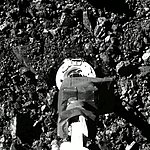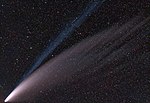TOI-561
TOI 561 is an old star, known to have multiple rocky planets.[1][2][3] It is an orange dwarf, estimated to be 10.5 billion years old, about 80 percent the mass of Sol, Earth's sun.[4][5]
In January 2021 a team lead by Lauren Weiss of the University of California, Riverside announced that, using data from NASA's Transiting Exoplanet Survey Satellite, they had found a Super-Earth, in a very close orbit.[6][7][4][1] The planet is approximately the same density as Earth, but three times as large. Because its year is measured in hours its surface temperature is estimated to be 2,000 degrees.
Team leader Weiss has said that the star is one of the most metal poor ever found.[5]
Another team led by Gaia Lacedelli of the University of Padua independently announced the discovery in a paper published in December 2020.[2] However, the two papers disagree on the structure of the system. While the innermost two planets were confirmed from TESS data by both papers, Weiss proposes only a single third planet in a 16.3-day orbit, while Lacedelli argues that the system instead contains two further planets, in wider orbits of 25.6 and 77 days.
References
- ^ a b
Weiss, Lauren M.; Dai, Fei; Huber, Daniel; Brewer, John M.; Collins, Karen A.; Ciardi, David R.; Matthews, Elisabeth C.; Ziegler, Carl; Howell, Steve B.; Batalha, Natalie M.; M> Crossfield, Ian J.; Dressing, Courtney; Fulton, Benjamin; Howard, Andrew W.; Isaacson, Howard; Kane, Stephen R.; Petigura, Erik A.; Robertson, Paul; Roy, Arpita; Rubenzahl, Ryan A.; Twicken, Joseph D.; Claytor, Zachary R.; Stassun, Keivan G.; MacDougall, Mason G.; Chontos, Ashley; Giacalone, Steven; Dalba, Paul A.; Mocnik, Teo; Hill, Michelle L.; et al. (2020), The TESS-Keck Survey II: Masses of Three Sub-Neptunes Transiting the Galactic Thick-Disk Star TOI-561, arXiv:2009.03071, doi:10.3847/1538-3881/abd409, S2CID 229279232
{{citation}}: CS1 maint: unflagged free DOI (link) - ^ a b
Lacedelli, G.; Malavolta, L.; Borsato, L.; Piotto, G.; Nardiello, D.; Mortier, A.; Stalport, M.; Collier Cameron, A.; Poretti, E.; Buchhave, L. A.; López-Morales, M.; Nascimbeni, V.; Wilson, T. G.; Udry, S.; Latham, D. W.; Bonomo, A. S.; Damasso, M.; Dumusque, X.; Jenkins, J. M.; Lovis, C.; Rice, K.; Sasselov, D.; Winn, J. N.; Andreuzzi, G.; Cosentino, R.; Charbonneau, D.; Di Fabrizio, L.; Martnez Fiorenzano, A. F.; Ghedina, A.; et al. (2021). "An unusually low density ultra-short period super-Earth and three mini-Neptunes around the old star TOI-561". Monthly Notices of the Royal Astronomical Society. 501 (3): 4148–4166. arXiv:2009.02332. doi:10.1093/mnras/staa3728. S2CID 221516470.
{{cite journal}}: CS1 maint: unflagged free DOI (link) - ^
Jean Schneider. "Planet TOI-561 b". Retrieved 2021-02-01.
{{cite news}}: CS1 maint: url-status (link) - ^ a b
Michelle Starr (2021-01-14). "Astronomers Find an Astonishing 'Super-Earth' That's Nearly as Old as The Universe". Science Alert. Retrieved 2021-02-01.
Around one of the galaxy's oldest stars, an orange dwarf named TOI-561 just 280 light-years away, astronomers have found three orbiting exoplanets - one of which is a rocky world 1.5 times the size of Earth, whipping around the star on a breakneck 10.5-hour orbit.
{{cite news}}: CS1 maint: url-status (link) - ^ a b
Natali Anderson (2021-01-13). "Astronomers Discover 10-Billion-Year-Old Multiplanet System". Sci-news. Retrieved 2021-02-01.
TOI-561 hosts at least three small transiting planets, named TOI-561b, c, and d, and is one of the oldest, most metal-poor planetary systems discovered yet in the Milky Way.
{{cite news}}: CS1 maint: url-status (link) - ^
Jules Bernstein (2021-01-11). "'Super Earth' discovered near one of our galaxy's oldest stars: Hot planet orbits its star twice during every Earth day". University of California Riverside. Retrieved 2021-02-01.
A hot, rocky "super Earth," near one of the oldest stars in the galaxy has taken a team of planet-hunting scientists by surprise.
{{cite news}}: CS1 maint: url-status (link) - ^
Doris Lam (2021-01-18). "All About The Discovery Of TOI-561b, The 14-Billion-Year-Old 'Super-Earth' Scientists Recently Found". Tatler magazine. Retrieved 2021-02-01.
{{cite news}}: CS1 maint: url-status (link)



